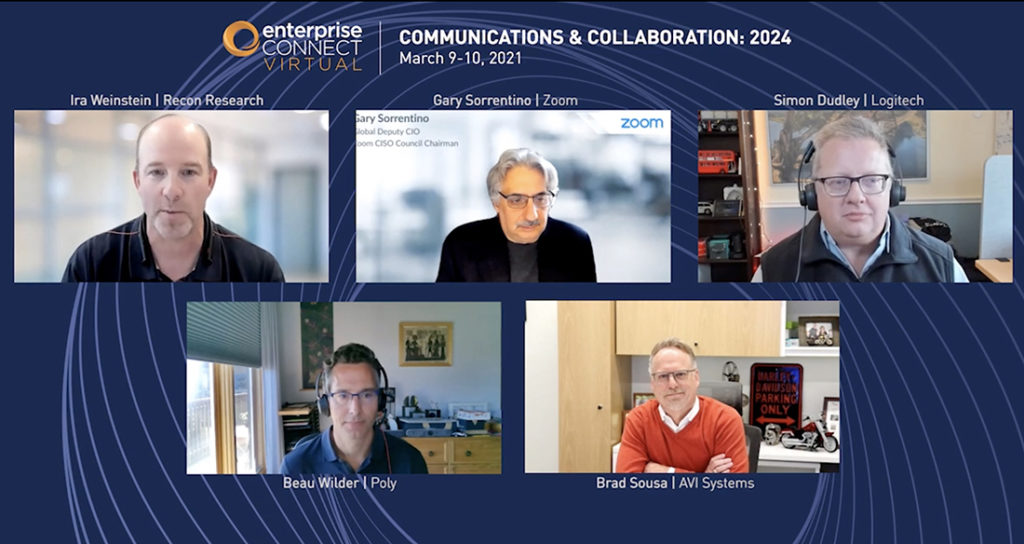Does the future of video conferencing lie in delivering a better user experience, updating meeting room systems or looking for creative ways to drive more value to the enterprise? According to experts at an Enterprise Connect Virtual session, “The Future of Video Conferencing,” the answer to all these questions is yes.
“Today, a good audio-visual experience is table stakes,” said Ira Weinstein, founder and managing partner, Recon Research. “Now is the time to look at older technology and see how you can improve user workflows and business processes.”
Weinstein moderated the Enterprise Connect discussion with panelists Gary Sorrentino, global deputy CIO, Zoom; Simon Dudley, analyst relations, Logitech; Beau Wilder, general manager, video collaboration, Poly; and Brad Sousa, CTO, Avi Systems.
“We are all using video conferencing these days to communicate and collaborate,” said Sousa. “Now, we need to think about how using that experience to bring more value to our users, as well as our business. For instance, how can video help your people become better doctors, teachers, customer service representatives or sales persons?”
Video can also help build coaching and mentoring relationships with team members who may be working from home or from the office, added Sousa. That’s an important step in creating a sense of community for a workforce in different locations.
Meanwhile, IT professionals can encourage creative thinking about the possibilities of video within the organization, said Sorrentino. “We can help users reimagine their jobs in different ways, such as demonstrating a business product or service,” he said. That could mean revising job descriptions or expanding responsibilities, since an effective video presence can transcend many geographic limitations.

Meeting room technology
Assessing and upgrading on-premise video conferencing technology should be another priority for IT leaders. “Video has become mission-critical technology,” said Dudley. “You need to have a consistent video experience in every meeting and it needs to work every time – otherwise, it’s useless.”
When Weinstein asked the panelists, what features will drive video’s value as people start to return to the office, the responses focused on ensuring health and safety, as well as simple setups and operations. “Keeping people safe is paramount,” said Sorrentino. That could mean contactless systems, operated by voice or a wireless smartphone application.
Along with hands-free equipment, Wilder suggested putting sensors in meeting rooms to generate data about usage. “For instance, you may want to limit the number of people in a room, based on current health and safety guidelines,” he said. “If there is a problem, users should get an alert in real time so they can take action.”
With a greater emphasis on video and less on face-to-face meetings, conference rooms may not need some of the attractive, customer-facing features of the past, said Sousa.
However, Weinstein raised the question of whether tomorrow’s video-equipped meeting rooms should be as flexible as possible to accommodate a wide range of users, or be set up for certain dedicated workflows, such as attorneys taking depositions from clients or medical professionals providing telemedicine services to clients. “You need to look at your desired outcomes and find the right platform and setting in the meeting room to embrace that workflow,’ he added.
Reflecting on the future of video conferencing, Weinstein told attendees, “Don’t accept mediocrity from technology. Keep your expectations high and make the technology serve you – not the other way around.”
